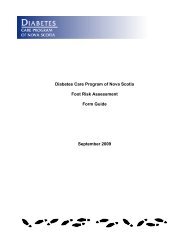CDE Appendix 1 Literature Review - Central East Local Health ...
CDE Appendix 1 Literature Review - Central East Local Health ...
CDE Appendix 1 Literature Review - Central East Local Health ...
You also want an ePaper? Increase the reach of your titles
YUMPU automatically turns print PDFs into web optimized ePapers that Google loves.
The Culture, Diversity and Equity Project: <strong>Literature</strong> <strong>Review</strong><br />
(CE, 2003). The (2003) Report opens up with the following twelve ‘Guiding Principles’ for cultural competence<br />
education and training of health care professionals (in no particular order):<br />
1. The goals of cultural competence training should be: 1) increased self- awareness and receptivity to diverse<br />
patient populations on the part of health care professionals; 2) clinical excellence and strong therapeutic<br />
alliances with patients; and 3) reduction of health care disparities through improved quality and costeffective<br />
care for all populations.<br />
2. In all trainings, there should be a broad and inclusive definition of cultural and population diversity<br />
including consideration of race, ethnicity, class, age, gender, sexual orientation, disability, language,<br />
religion and other indices of difference.<br />
3. Training efforts should be developmental, in terms of the institution and the individual. Institutions may start<br />
out simply in their inclusion of cultural competency training as a specific area of study but are<br />
expected to build in more complex, integrated and in-depth attention to cultural issues in later stages of<br />
professional education. Trainees should be expected to become progressively more sophisticated in<br />
understanding the complexities of diversity and culture as they relate to patient populations and health<br />
care. Both instructional programs and student learning should be regularly evaluated in order to provide<br />
feedback to the on-going development of educational programs.<br />
4. Cultural competence training is best organized around enhancing providers’ attitudes, knowledge and skills, and<br />
attention to the interaction of these three factors is important at every level of the training. It is important to<br />
recognize the extensive pre-existing knowledge and skill base of health care professionals, and to seek to<br />
promote cultural competence within this context.<br />
5. While factual information is important, educators should focus on process-oriented tools and concepts<br />
that will serve the practitioner well in communicating and developing therapeutic alliances with all types of<br />
patients.<br />
6. Cultural competence training is best integrated into numerous courses, symposia and experiential,<br />
clinical, evaluation and practicum activities as they occur throughout an educational curriculum. Attention<br />
may need to be directed to faculty, staff and administrative development in cultural competence in order to<br />
effect this integration.<br />
7. Following on the above, cultural competence education should be institutionalized within a school<br />
or health care organization so that when curriculum or training is planned or changed, appropriate<br />
cultural competence issues can be included.<br />
8. Cultural competence education is best achieved within an interdisciplinary framework and context, drawing<br />
upon the numerous fields that contribute to skill and knowledge in the field.<br />
9. Education and training should be respectful of the needs, the practice contexts and the levels of<br />
receptivity of the learners.<br />
10. Education in cultural competence should be congruent with, and, where possible, framed in the context of<br />
existing policy and educational guidelines of professional accreditation and practice organizations, such<br />
as the Accreditation Council on Graduate Medical Education, the Liaison Committee on<br />
Medical Education, the American Academy of Nursing, the National Association of Social Workers,<br />
the Society for Public <strong>Health</strong> Education and the Academies and Colleges of Family Practice,<br />
Paediatrics, Emergency Medicine and Obstetrics and Gynaecology.<br />
11. Wherever possible, diverse patients, community representatives, consumers and advocates should participate<br />
as resources in the design, implementation and evaluation of cultural competence curricula.<br />
12. Finally, cultural competence education should take place in a safe, non- judgmental, supportive<br />
environment. While the Principles and Recommended Standards are focused on the education and training<br />
of health care professionals, the schools and organizations in which they study and work must be<br />
settings that are conducive to functioning in a culturally competent way and visibly support the goals of<br />
culturally competent care.<br />
102

















